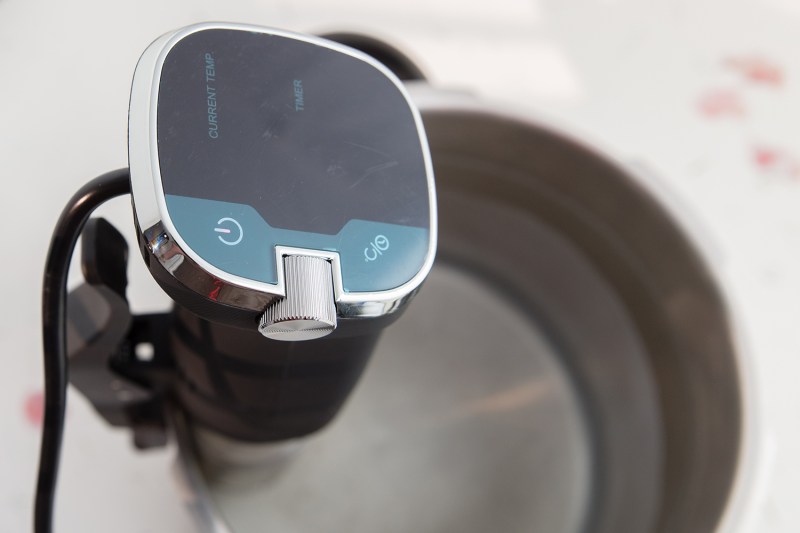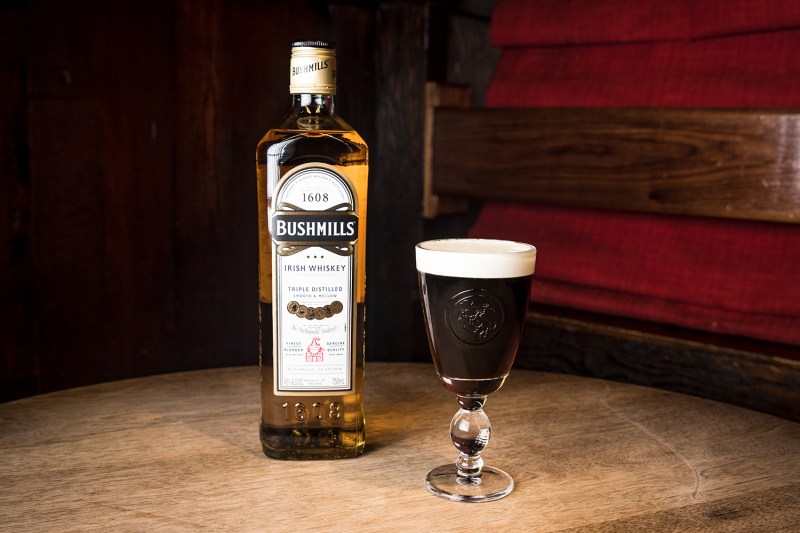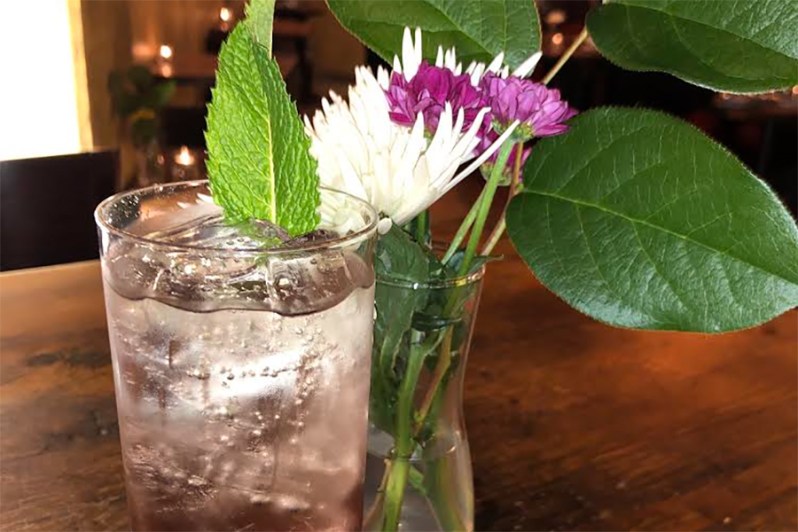High-end kitchen gadgets are having an undeniable moment right now; while items like pressure cookers, top-notch knives, and sous-vide machines once seemed the exclusive domain of pro chefs and especially skilled amateurs, we now see plenty of regular folks without classical culinary training adding these devices to their wedding registries and holiday wish lists. And thanks to the popularity of shows like Top Chef and Chopped (as well as infinite YouTube cooking videos), at-home cooks now feel empowered to roll up their sleeves and give this fancy equipment a try in the comfort of their own kitchens.

The sous vide machine proves an especially apt example of this shift, since very few non-professional cooks made use of this tool up until a few short years ago. Named for a French term that literally translates to “under vacuum,” sous vide machines allow users to put ingredients into sealed plastic vessels and then submerge them in warm (but not boiling) water to cook. This slow and gentle process is best-known for producing tender and juicy meats, but the usefulness of the sous vide machine can extend far beyond a perfect medium-rare filet. Lately, creative bartenders have been experimenting with sous vides, using the low-and-slow cooking rhythm and the vacuum pressure to boost the flavors and the strength of their cocktails. And, according to the bartenders we interviewed, anyone with the right equipment at home can (and should) feel free to go full-on “mad scientist” and whip up their own sous vide cocktails.
(You can check out more about sous vide here.)
How does the sous vide method work for cocktails?
The sous vide process for cocktails bears a lot of similarity to the method for proteins and other solid foods. It’s all about the slow cook at a low temperature, bolstered by the pressure and protection of the sealed bag or jar or plastic container. “The sous vide method [for food] allows the food to cook in its own juices at a slower [pace], without any outside elements to compromise the flavor. I thought, ‘Why not use this with a cocktail?’ and it worked great and blew my mind,” beverage curator (and sous vide cocktail enthusiast) Brooke Sutter of E3 Chophouse in Nashville tells us.
What impact does the sous vide process have on cocktail flavor and potency?
“Sous vide allows for longer, deeper flavor development. The low temperature means that some infusions and wine and spirits blends can be mixed directly together, instead of [using] separate processes,” bar program designer and recipe developer Suzannah Gerber of @chefsuzidarlin insists.
“Sous vide does wonders for cocktail components because it’s replicable and consistent. Some spices like a long, slow steep to get details from their character, but with the application of a little heat, the whole process speeds up.”
Co-founder Will Wyatt of Mister Paradise in New York City agrees with this estimation, adding that “cooking a cocktail [with a sous vide] helps the various flavors combine and hold together. Similar to aerating a cocktail while shaking it to mix the ingredients, cooking and partially evaporating a cocktail inside a sealed bag allows the ingredients to settle back together as one cohesive liquid with a uniform flavor. I also find that cooking spirits tend to soften them a bit, taking the bite out of whiskey and the like.”
Tom Santelle, the Head of Coffee and Tea at Band of Bohemia in Chicago (who uses a sous vide to make beverages on a regular basis) has a science-based viewpoint on this topic: “Sous vide does wonders for cocktail components because it’s replicable and consistent. Some spices like a long, slow steep to get details from their character, but with the application of a little heat, the whole process speeds up. Ethanol is a pretty strong solvent, and heat just speeds up the reaction. Cinnamon and cardamom are the easy go-tos for infusions, but spices that like a little more ‘cooking’ like star anise usually don’t do well with a cold steep. With a ‘low and slow’ sous vide cook, you can preserve the freshness and detail of fresh herbs and spices without the ‘browned’ or ‘cooked’ tastes associated with even the most careful stovetop cooking. As a bonus, it’s replicable because there is a specific time and temperature built into the recipe if you need to do exactly the same thing twice.”
Can you use an at-home sous vide machine to make these drinks?
“A sous vide is a sous vide,” beverage director Jillian Vose of The Dead Rabbit in NYC says in no uncertain terms, dispelling any fears that an at-home sous vide machine might not be up to the cocktail-making challenge. Will Benedetto, the director of bars for IGC Hospitality in NYC, concurs, offering up the following recommendations for choosing a sous vide machine: “Sous vide refers to the method of using an immersion circulator to hold water at precise temperatures above that of room temperature. Immersion circulators have gotten really cheap. Commercially, we use expensive versions that are designed to bring large volumes of water to high temp for literally days at a time. But for most bars that only need a sous vide rig for hours at a time or for home use, you can find many great options for around $150.”
Further Reading:
Looking for some sous vide-specific cocktail tips? Our experts have got you covered. Sutter advises sous vide cocktail newbies to take advantage of the sous vide’s slow-and-steady pace by experimenting with unusual flavors and combinations. “Don’t be afraid to try something out of your comfort zone. Pick some flavors that might not be ‘ordinary’ and start testing. I personally like to push the boundaries with herbs. I have done lots of testing with rosemary and thyme; if they are [cooked] sous vide too long sometimes they can come out very bitter, so there’s a lot of trial and error [involved]. Don’t let that stop you. It can be a very fun process, and there is some science involved. The reward can be very unique and refreshing.”
Wyatt cautions sous viders to choose their supplies wisely: “[If you’re sous viding in a bag,] make sure you buy boil-safe Ziplocs, since you want to cook them at 180 degrees Fahrenheit so that some of the alcohol starts to evaporate. Other than that, it really is as simple as putting liquid in a bag and placing it in a water bath.”
Don’t try to sous vide your cocktails in a hurry, insists Santelle: “Don’t rush the cook. Every single time I’ve tried to do a four-hour [sous vide] cook in exactly four hours (without adding warm-up and cooling time), I came up with a seriously lacking result.”
If you want to “start small” by hewing closely to familiar flavors and using lower cooking temperatures to keep infusions subtle, follow Gerber’s lead and “stick to lower temperatures at first- under 130 degrees- and let [the drink] sit and taste along the way to get a feel for what extraction rates you prefer. Consider composed drinks like mulled wine and adult spicy hot chocolate, and toddies with every imaginable flavor variation, and [think of] the sous vide as your one-pot cooking method for all these classics.”
Sous Vide Cocktail Recipes
Now, it’s time to get off to a strong sous vide start with these two flavorful (and surprisingly simple) cocktail recipes:
The Dead Rabbit Irish Coffee

(Created by Jack McGarry and Jillian Vose, co-founder and beverage director, respectively, The Dead Rabbit, New York City)
When bartenders at The Dead Rabbit make the bar’s iconic Irish coffee, they need to keep the coffee-and-sugar base consistently hot and well-integrated … and, considering the massive volume of Irish coffee-drinking clients lining up at The Dead Rabbit on a nightly basis, that’s no easy feat. Luckily, the legendary bartenders behind The Dead Rabbit came up with an excellent solution to their problem: using a sous vide to maintain the coffee mixture’s heat and flavor balance. “The point of using the sous vide to keep our coffee & Demerara sugar mix piping hot is that it doesn’t affect the flavor or cause evaporation. It just keeps a consistent temperature and flavor. If you were to use drip coffee and keep it over direct heat, it would eventually burn the coffee, which is quite unpleasant to taste and smell. Direct heat in regards to the sugar would cause caramelization, therefore also affecting the flavor. [The sous vide] doesn’t burn the coffee, it keeps it hot, and it’s clean and efficient,” Vose explains.
- 3.5 oz drip coffee
- .625 oz Demerara sugar syrup (2 parts sugar to 1 part water, boiled over high heat until the sugar dissolved and set aside to cool)
- 1 oz blended Irish whiskey (The Dead Rabbit uses Bushmills Original)
- Freshly-whipped, unsweetened heavy cream, to taste (TDR recommends cream with 35-38% fat content)
Method: Heat the water in your sous vide machine to 80 degrees Celsius (176 degrees F). Mix hot coffee and Demerara sugar syrup until fully combined. Pour the coffee-sugar mixture into a food grade plastic bottle and submerge in the water until ready to serve. Add whiskey to a 6 oz Irish coffee glass and then pour in the coffee mixture, leaving an index-finger amount of space for the cream float. Top with whipped cream, which should be pourable, with no bubbles, To achieve that texture, whisk in a cold metal vessel and keep over a bed of crushed ice, or use a protein shaker.
Blackberry Basil Moonshine Fizz

(Created by Lorraine D. Lane, beverage director, Twisted Soul Cookhouse & Pours, Atlanta, Georgia)
Lane likes to use the sous vide method when making herbaceous cocktails because “it enhances the herbs in the cocktail. One of our sous vide cocktails, Blackberry Basil Moonshine Fizz, combines moonshine, fresh blackberries, and basil, an herb that complements the tartness of the blackberries. It’s a flavor that you could not get if you were simply muddling the ingredients.” She uses the sous vide machine to infuse moonshine (aka white whiskey, a high-proof and neutrally flavored spirit that’s ideal for this purpose) with berries, creating a cocktail base that cooperates beautifully with the herb notes in the basil syrup.
- 1.5 oz white whiskey/”moonshine” (Lane uses American Born White Lightning)
- Blackberries, to taste
- Basil, to taste
- 1.5 oz Cointreau
- .75 oz basil-infused simple syrup *
- Tonic water, to taste
Method: Heat the water in the sous vide machine to 135 degrees Fahrenheit. Add whiskey, blackberries, and basil to a Mason jar and submerge in the sous vide water. Allow to cook for 3 hours. Discard blackberries and basil, then allow liquid to cool. Add infused whiskey, Cointreau, and infused simple syrup to a shaker and shake well. Pour into a Collins glass over ice. Top with tonic and garnish with a basil leaf and a blackberry.
*Basil infused simple syrup:
- Add 1 cup of water, 1 cup of sugar, and basil (to taste) to a saucepan.
- Boil for 60 seconds, then remove from heat and steep for 30 minutes.
- Remove basil and pour syrup into a jar for storage.
Editors' Recommendations
- Get creative: How to use hibiscus in your cocktails this spring
- You should know how to make these incredible sauces
- Here’s all you need to know about brisket: A comprehensive guide
- The best tea cocktail recipes if you love a hot toddy
- 12 tasty, versatile sake cocktails to whip up and enjoy


